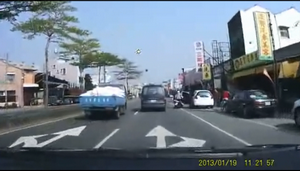The Lessons Paid for in Blood!
- Date:2016-04-15
- Update:2019-10-29
- Department:IOT

Did you know that roadside parking is the biggest problem between motorcycles and cars on the road? Did you know there are always two or three simple safety behaviors that can prevent these collisions ?
The Institute of Transportation, MOTC found that from 2007-2011 aabout 850,000 accidents between cars and motorcycles happened, making it fthe most important safety problem for motorcycles on the road. This type of accidents accounts for 20.6%, including drivers not paying attention when opening their door or starting off, and parking violations.
The actual reasons causinge the accidents can be quite complex, including external environmental factors, personal driving skills, and the hazard perception abilities. The Institute of Transportation collected and analyzed the accidents systematically through video cases, probed the risk factors for different types of accidents, and then educated drivers about appropriate behavior rand prevention in different risk situations, in order to enhance their hazard perception abilities and safe driving skills.
For example, the main risk factors of the motorcycle and car collapse caused by opening the doors are:
1. the driver
(1) erroneously believes that there is no problem to park the car on the street
(2) erroneously believes that opening the door without paying attention wouldn’t collapse the motorcycle
(3) doesn’t know the blind spot phenomenon
(4) doesn’t understand that the width of an opened door could be a danger to the coming motorcycle.
(5) didn’t see the coming motorcycle while opening the door
(6) did see the motorcycle coming from behind, but not realize how close it was
(7) misjudged the speed of motorcycle, the gap or the space between motorcycle, or erroneously assumed that motorcycle could dodge
2. the rider
(1) did not anticipate that the door of the parked car could be opened, erroneously assumes he can pass safely
(2) didn not know or ignored the parked car door could be opened at any time
(3) did not see the driver in the car
(4) did not foresee that the driver wanted to get off
(5) misjudged the speed, the brake performance, and the distance from car
(6) misjudged the space between the car on their left-hand side, so that have no chance to steer to the left to dodge.
Measures against human errors:
1. the driver
(1) understand the hazards of parking on street, double parking, opening the door without observing, and understands the problem of the car’s blind spot
(2) form good habits: always assess the traffic situation first before opening the door. The method of confirmation is observing the mirror, turning your head and scanning the traffic, and grow the habit of opening the door safely, e.g. by opening the door in two phases (open 5-15 cm width first to observe, then open totally after confirmation), using back-hand to open (using right hand to open left-hand door while get off from left-hand side, using left hand to open right-hand door while get off from right-hand side)
2.the rider
(1) understand the blind spot problem of the car, understand the hazard of parked cars on the street, which could open their doors suddenly
(2) form good habits: always keep a safe distance from a parked car (at least one-door-width)
(3) keep dodge space in advance, scanning the traffic at any time, remaining the proper speed in case it’s too late to respond.
File Download
- 20160415-news.pdfCounter:257







